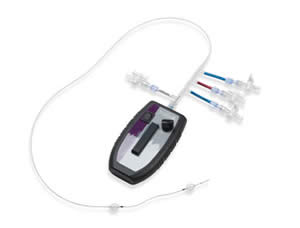What is
Deep Vein Thrombosis
DVT is a dangerous blood clot that develops in your deep veins causing blood thrombosis. Clots like this are potentially life threatening because they can break apart, sending large and/or small pieces to your lungs, hearts, or brain (if you have a heart condition called patent foramen ovale). These broken off clot pieces then get lodged in a vessel, and effectively block off the circulation to that area. This can cause you to not be able to get oxygen and suffocate and die. Or you may develop a stroke. Or permanently damage the deep veins, causing poor circulation in the legs, swelling and leg pain, darkening of the ankle area skin, and/or foot wounds that won’t heal.
A well known NBC News correspondent David Bloom who was embedded with the 3rd Infantry Division during the war in Iraq, suffered a DVT which sent a large blood clot to his lungs and died from it. When it travels to the lung, it’s called pulmonary embolism.
Standard DVT treatment in Phoenix AZ area have been to hospitalize the patient for several days, place patients on medications known as blood thinners hoping to prevent more DVT from forming. Mind you, the blood thinners do NOT dissolve your clots. It merely prevents more clots from forming, and it requires your own body to try to dissolve them, usually taking around 6 months of time and damaging your vein valves and veins during that time. Sometimes, you’d need to be on the blood thinning medication for 6-12 months or life long, requiring blood draws lab tests weekly, depending on your circumstances.

How Common is DVT?
DVTs are so common that every day, there are hundreds of people being diagnosed in Phoenix area, especially for patients who have surgery on a joint such as the hip or knee, or any other surgery procedures. And this is the precise reason why now the government stepped in, requiring ALL hospitals to DVT preventive medications before any surgeries. I have known some surgeons whose patients died from DVTs after a routine surgery like laparoscopic cholecystectomy because he didn’t give him preventive medication. The consensus estimate of people developing DVT in US is about 400,000 every year!
Usually patients are not familiar with the symptoms of DVT, and dismiss their persistent cramp like pulled muscle in the legs, swelling, heaviness, and/or pain. Other more serious symptoms can arise such as difficulty breathing, heartbeat racing faster, etc. People often think they had pneumonia or bronchitis. Duplex Ultrasound is the number one choice for diagnosing DVT before more serious symptoms arise.
Patients who are currently getting treatment for cancer should watch for any signs or symptoms of DVT. Luckily, Trellis treatment is effective upto six weeks after the DVT started, although individual evaluation and variation are common. Trellis is a local out-patient procedure using lidocaine. If you do get anxious, then mild sedative can be given as well.
Symptoms
Deep vein thrombosis can take place for months or even years with absolutely no side effects. During the acute stage, a pulmonary embolism may occur causing chest pain and maybe even death.
With that being said, most patients will begin to notice at least some minor signs that something is wrong such as leg swelling, tenderness, warmth, and redness of the legs. Many patients believe they have an infection or have sprained a muscle in their leg.
- Leg swelling
- Leg heaviness
- Cramping or charlie horse
- Pain
- Muscle pulling sensation
- Difficulty breathing
- Heart beat racing
Risk Factors
For the past 60 years, the standard of care for DVT has been anticoagulation therapy, i.e., blood thinners. Blood thinners work well in reducing the chance of the blood clot growing and of the patient developing a fatal pulmonary embolism. However, many people incorrectly believe that blood thinners can fully dissolve a blood clot on their own.9
By leaving the clot in the vein, a patient runs the risk of developing a condition called post thrombotic syndrome.19 Three key minimally invasive treatment methods exist for treating DVT: catheter directed thrombolysis, pharmacomechanical thrombolysis and isolated pharmacomechanical thrombolysis.
Risk factors include:
- Prolonged bed rest
- Having family members who had DVTs
- Cancer
- Surgeries
- Spinal cord injuries
- Pregnancy and/or giving birth
- Age over 40
- Smoking
- Varicose veins
- Long air flights or car rides
- Overweight
- Birth control pills
- Hormone replacements or medication
Treatment for DVT
The Trellis
A new treatment that has been used effectively in many different states have already been performed by Dr. Kim in East Valley of Phoenix AZ. It’s a device called Trellis which safely traps the clot so they don’t break off and travel to your vital organs, and actually dissolve and break up the clots and suction them out — all in a procedure that takes about half an hour.
How it works
It uses two tiny balloons, one above and one below the clot, to keep the clot-dissolving medication only where it’s needed, and then use a vibration roto-rooter type of soft wire to blenderize the clot. Afterwards, the blenderized clot is suctioned out. Other similar attempts have been tried before individually 1) giving clot-dissolving medication to the entire body, or 2) blenderizing the clot but risking the broken clot materials to travel to your lung, heart, and/or brain. Clot dissolving medications are powerful yet dangerous medication which you do NOT want anywhere else in your body except where the clot is located. But Trellis combined the two method, and made it safer by using the balloons to make sure neither the clot-dissolving medication or the blenderized clot can travel.






